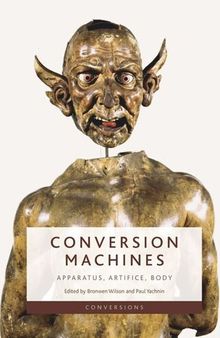دانلود کتاب Conversion Machines: Apparatus, Artifice, Body
by Bronwen Wilson (editor), Paul Yachnin (editor)|
|
عنوان فارسی: ماشین های تبدیل: دستگاه، مصنوعی، بدنه |
 دانلود کتاب
دانلود کتاب
 جزییات کتاب
جزییات کتاب
Brings forward the history of made things and the history of practices as a new way of understanding the social and political dimensions of early modern conversion (mostly religious conversion but also bodily, sexual, and machine-to-human kinds of transformation)Engenders a multidisciplinary approach to conversion as a process of change – including history, art and architectural histories, literary studies, and philosophyFocuses on the 16th and 17th centuries with case studies of conversion machines that operated in England, New Spain, Italy, the Low Countries, France, and islands in the Mediterranean Develops accounts of systems and mechanisms for attracting converts, and for managing, manipulating, and staging conversions Individual chapters focus on literary works such as Hamlet, The Temple by George Herbert, and L’Isle des Hermaphrodites; works of art and architecture by Jacopo Ligozzi and Claudio de Arciniega, and thinkers such as Augustine, Descartes, and LeibnizIndividual chapters focus on spaces, movement, visions, sensory experiences, material, spiritual, and bodily transformations that are highly self-aware and inventive thingsConcludes with a pairing of philosophical chapters on what machines cannot do" and on "human conversion machines"
Conversion machines are apparatuses, artfully-fashioned preparations, arrangements, and things that demonstrate processes of change. They are paradoxical things – at once intent on verifying what was invisible, uncertain, and even unknowable, while also acting as sowers of dissimulation. The book does not seek to mechanize conversion. In many ways, conversion and the transformation of the convert will remain ineffable. But we maintain that conversion of all kinds must unfold in ecologies that include politics, law, religious practice, the arts, and the material and corporeal realms. Shifting the focus from subjectivity toward the operations of governments, institutions, artifices, and the body, the contributors to the volume consider how early moderns suffered under the mechanisms of conversion, sometimes were able to realize themselves by dint of being caught up in the machinery of sovereignty, invented scores of new, purpose-built conversional instruments, and experienced forms of radical transformation in their own bodies.









 این کتاب رو مطالعه کردید؟ نظر شما چیست؟
این کتاب رو مطالعه کردید؟ نظر شما چیست؟
